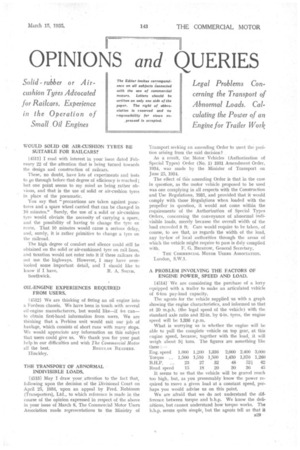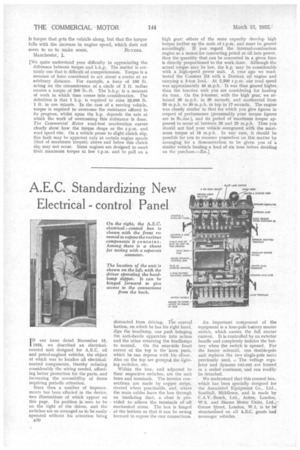OPINIONS and QUERIES
Page 43

Page 44

If you've noticed an error in this article please click here to report it so we can fix it.
WOULD SOLID OR AIR-CUSHION TYRES BE SUITABLE FOR RAILCARS?
[4511] I read with interest in your issue dated February 22 of the attention that is being turned towards the design and construction of railcars.
These, no doubt, have lots of experiments and tests to go through before that degree of efficiency is reached ; but one point seems to my mind as being rather obvious, and that is the use of solid or air-cushion tyres in place of the pneumatic.
You say that " precautions are taken against punc-! tures and a spare wheel carried that can be changed in 10 minutes." Surely, the use of a solid or air-cushion tire would obviate the necessity of carrying a spare, and the possibility of having to change the tyre en route. That 10 minutes would cause a serious delay, and, surely, it is rather primitive to change a tyre on the railroad.
The high degree of comfort and silence could still be obtained on the solid or air-cushioned tyre on rail lines, and taxation would not enter into it if these railcars do not use the highways. However; I may have overlooked some important detail, and I should like to know if I have. R. A, SMITH. Southwick.
OIL-ENGINE EXPERIENCES REQUIRED FROM USERS.
1.4512) We are thinking of fitting an oil engine into Fordson chassis. We have been in touch with several oil engine manufacturers, but would like—if 4-e canto obtain first-hand information from users. We are thinking that a Perkins unit would suit our job of haulage, which consists of short runs with many stops. We would appreciate any information on this subject that users could give us. We thank you for your past help in our difficulties and wish The Commercial Motor
al/ the best. REGULAR READERS. IIinckley.
THE TRANSPORT OF ABNORMAL INDIVISIBLE LOADS.
[45131 May I draw your attention to the fact that, following upon the decision of the Divisional Court on April 25, 1934, upon an appeal by Fred. Robinson (Transporters), Ltd., to which reference is made in the course of the opinion expressed in respect of the above in your issue of March 8, The Commercial Motor Users Association made representations to the Ministry of Transport seeking an amending Order to meet the position arising from the said decision? .
As a result, the Motor Vehicles (Authorization of Special Types) Order (No: 1) 1931 Amendment Order, 1934, was made by the Minister of Transport on June 25, 1.934.
The effect of this amending Order is that in the case in question, as the motor vehicle proposed to be used was one complying in all respects with the Construction and Use Regulations, 1931, and provided that it would comply with those Regulations when loaded with the propeller in question, it would not come within the requirements of the Authorization of Special Types Orders, concerning the conveyance of abnormal indivisible loads, merely because the overall width of the load exceeded 8 ft: Care would require to he taken, of course, to see that, as regards the width of the load, any by-law of local . authorities through the areas of which the vehicle might require to pass is duly complied with. F. G. BRISTOW, General Secretary, • THE COMMERCIAL MOTOR USERS ASSOCIATION. London, S.W.1.
A PROBLEM INVOLVING THE FACTORS OF ENGINE POWER, SPEED AND LOAD.
[4514] We are considering the purchase of a lorry equipped with a trailer to make an articulated vehicle of 6-ton pay-load capacity.
The agents for the vehicle supplied us with a graph showing the engine characteristics, and informed us that at 20 m.p.h. (the legal speed of the vehicle) with the standard axle ratio and 32-in, by 6-in. tyres, the engine speed will be 1,336 r.p.ra.
What is worrying us is whether the engine will be able to pull the complete vehicle on top gear, at this engine speed, because, together with the load, it will weigh about 9f tons. The figures are something like It seems to us that the vehicle will be geared much too high, but, as you presumably know the power required to move a given load at a constant speed, perhaps you would advise us on this point.
We are afraid that we do not understand the difference between torque and b.h.p. We know the definitions, but cannot understand how torque works. The b.h.p, seems quite simple, but the agents tell us that it is torque that gets the vehicle along, but that the torque falls with the increase in engine speed, which does not seem to us to make sense. BUYERS. Manchester, 1.
[We quite understand your difficulty in appreciating the difference between torque and b.h.p. The matter is certainly one that is difficult of comprehension. Torque is a measure of force considered to act about a centre at an arbitrary distance. For example, a force of 100 lb. acting on the circumference Of a circle of 2 ft. radius creates a torque of 200 lb.-ft. The b.h.p. is a measure of work in which time comes into consideration. The definition is that I h.p. is required to raise 33,000 lb. 1 ft. in one minute. In the case of a moving vehicle, torque is required to overcome the resistance offered to its progress, whilst upon the h.p. depends the rate at which the work of overcoming this resistance is done. The Commercial Motor road-test acceleration curves clearly show how the torque drops as the r.p.m. and road speed rise. On a vehicle prone to slight clutch slip, this fault may be apparent only at certain engine speeds (that of maximum torque); above and below this clutch slip may not occur. Some engines are designed to exert their maximum torque at low r.p.m. and to pull on a
high gear; others of the same capacity develop high torque farther up the scale of r.p.m. and must be geared accordingly. If you regard the internal-combustion engine as a means for converting petrol or oil into power, then the quantity that can be converted in a given time is directly proportioned to the work done. Although the actual torque may be low, the h.p. may be considerable with a high-speed power unit. A year ago we roadtested the Commer B3 with a Dorman oil engine and carrying a 3-ton load. At 2,500 r.p.m. our road speed was approximately 45 m.p.h. It was thus geared higher, than the tractive unit you are considering for hauling six tons. On the 3-tonner, with the high gear,' we attained 30 m.p.h. in 30 seconds, and accelerated from 20 m.p.h. to 30 m.p.h. in top in 17 seconds. The engine was closely similar to that for which you give figures in respect of performance (presumably your torque figures are in lb.-ins.), and its period of maximum torque appeared to occur at between 20 and 25 m.p.h. Thus you should not find your vehicle overgcared with the maximum torque at 18 m.p.h. In any case, it should be possible for you to reassure yourselves on this matter by arranging for a demonstration to be given you of a similar vehicle hauling a load of six tons before deciding on the purchase.—En.]




























































































